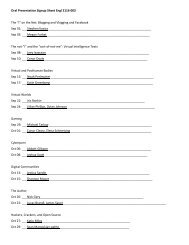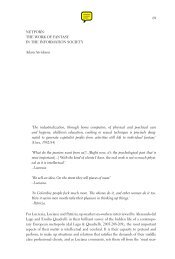Nakamura, Digitizing Race, Introduction, chapter 5, Epilogue
Nakamura, Digitizing Race, Introduction, chapter 5, Epilogue
Nakamura, Digitizing Race, Introduction, chapter 5, Epilogue
Create successful ePaper yourself
Turn your PDF publications into a flip-book with our unique Google optimized e-Paper software.
“Ramadan Is Almoast Here!” 41<br />
in The Simpsons shows, the use of “brownvoice” as a form of electronically<br />
mediated passing has been a feature of Asian American representation for<br />
many years and across media forms. 7 The makers of Tizzle Talk, which is<br />
available for free download at www.tizzletalk.com, anticipate that users will<br />
find the software offensive, explaining, “We are a diverse bunch. Tizzle Talk<br />
originally started as a way to make fun of ourselves,” thus deflecting accusations<br />
that they are engaging in cross-racial mimicry by whites “against” nonwhite<br />
groups. Though Tizzle Talk has not become a widespread IM helper<br />
application, due partly at least to the inconvenience and difficulty of speaking<br />
or reading in “Dubya” for extended periods of time, the practice of using<br />
graphical buddy icons is widespread, and Tizzle Talk includes these to enhance<br />
the sense of racial presence that it parodies.<br />
AIM buddies are tiny bits of screen real estate that operate in several<br />
registers. They can work to signify identity in a straightforwardly pragmatic,<br />
relatively nonideological way, for when conducting multiple IM conversations,<br />
users quickly track who is speaking or “texting” by glancing at their<br />
AIM buddy icon. The icons serve as visual flags for shaping the tendency<br />
toward distraction that characterizes this type of online activity. Buddies<br />
help users with multiple windows open to organize their attention. These<br />
icons perform an important cognitive as well as signifying function in the<br />
world of IM. However, users do frame their posts with numerous visual objects<br />
that are strongly valenced in terms of gender, racial, ethnic, national, and<br />
religious identity, the buddy icon being just one among them. If we wish to<br />
parse the meanings of this immensely popular application, one that defines<br />
the Internet as a communicative tool for vast numbers of its users, we would<br />
do well to examine its visual culture. AIM buddies and other user-chosen<br />
IM images are the product of a user’s desire to create a desktop mise-en-scène<br />
that signifies the self, and they are thus part of an ongoing process of digital<br />
racialization. They constitute part of a new visual culture, a visual culture<br />
imbricated within a peculiarly oral discursive form, the online chat, that<br />
brings together cinema, signboard culture, and the graphic novel and works<br />
to literally embody desubstantialized and ephemeral virtual speech. AIM<br />
buddies run the gamut of cartoon characters, television and movie stars,<br />
and figures from fantasy and mythology. It appears that anything from a<br />
scanned photograph of Jennifer Aniston to a cell-phone-camera image of<br />
the user’s cat can be (and almost certainly is) an AIM buddy. These tiny<br />
graphical images function as remediations of both older visual media and<br />
“sigs,” or the automated identifiers appended to the end of e-mail messages<br />
from back in the days of text-only Internet. AIM buddies occupy a liminal





